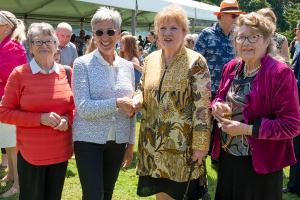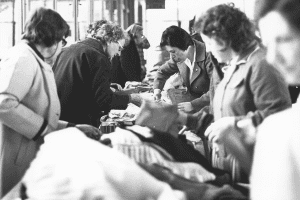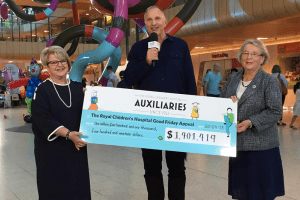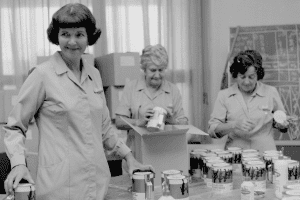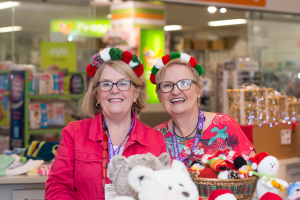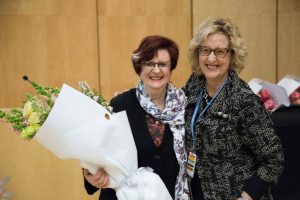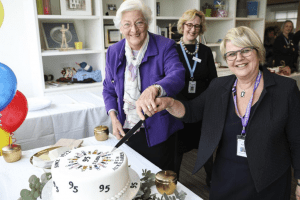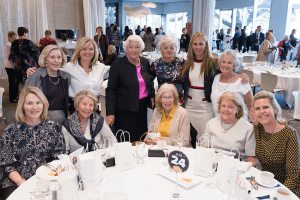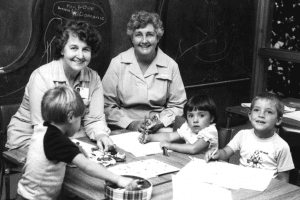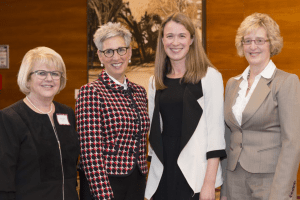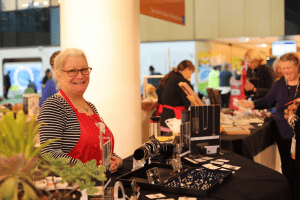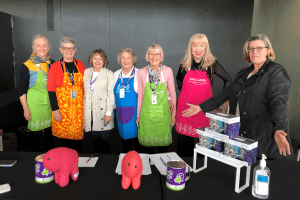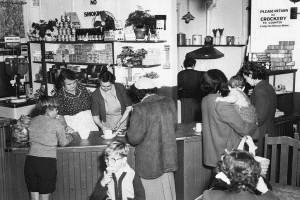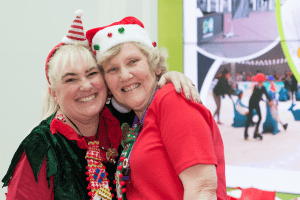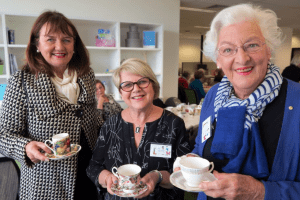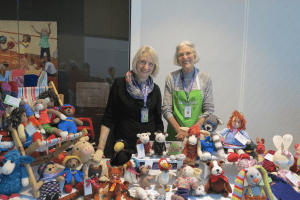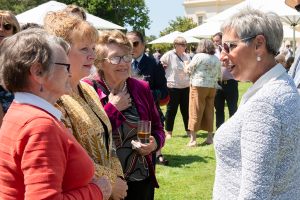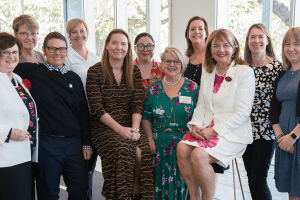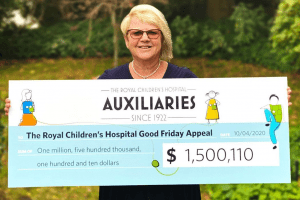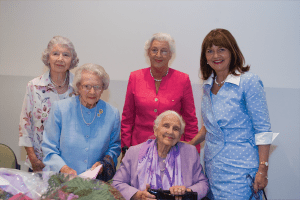The vibrant and dynamic RCH Auxiliaries are a fundraising force to be reckoned with, and in 2022, these incredibly dedicated and passionate volunteers are celebrating 100 years of supporting the hospital.
The RCH Auxiliaries were first established in 1922 by Miss Mary Guthrie after she raised concerns with the Hospital Committee of Management about the financial capacity of the hospital. As a solution, Miss Guthrie formed the Auxiliary movement, as a way to create a steady stream of fundraising income to supplement other private donations and Government grants. They would also make and supply clothing, hospital garments and bed linen to the hospital. By the end of 1922, there were nine Auxiliary groups, along with an Executive Council, all committed to improving the lives of the state’s most vulnerable children.
Now, 100 years later, there are 48 active Auxiliary groups and over 450 members who all fundraise under the mission: “One team working towards one goal – making sick kids better.” Together, they have raised over $44.5 million and supported countless life-changing projects at the RCH.
Since their establishment, the Auxiliaries have had a remarkable impact on the lives of Victoria’s sickest children, from funding world-class projects and initiatives, to enabling the advancement of nurses through the Dame Elisabeth Murdoch Nursing Development Scholarship, and even brightening the day for patients with personal handmade quilts. As avid fundraisers, they have developed a longstanding relationship with the Good Friday Appeal since its inception in 1931, including their involvement in the Kids Day Out and annual cheque presentation. Throughout the years, the Auxiliaries have instigated several iconic fundraising initiatives; in 1991 they held the first ‘Cuppa for Kids’ fundraising event which raised $22,000 in its first year, they raised over $1 million from the sale of Auxiliaries tote bags and introduced internal market stalls at the hospital which are much loved by staff and families.
Above all else, it is the individuals who make up the Auxiliaries who are the heart and soul of the operation. Some members have experienced the care of the hospital directly. Others are second, third and even fourth generation Auxiliary members, a tradition passed down in their family. Then there are those who are just passionate about giving back to the community. No matter how they became involved, each member has one thing in common – a shared goal of helping sick children. It is that unwavering dedication that drives them to knit, crochet, bake, create quilts, man stalls, and organise events.
In recognition of their centenary, a series of celebratory events and initiatives will be delivered throughout 2022 as part of the Auxiliaries Centenary Program, including a high tea, the publishing of commemorative publications and the use of special centenary branding.
Dr Miriam (Mim) Weisz OAM, President of the RCH Auxiliaries, said that Auxiliaries Centenary Program will acknowledge the incredible history of the Auxiliaries and celebrate the many hardworking individuals who have dedicated countless hours to helping others.
“The Auxiliaries are the heart and soul of the hospital, so we look forward to recognising the incredible impact they, as a group, have had on sick children in Victoria and beyond. As well as this, it is also an opportunity to honour and thank all members, past and present, for the significant role they play in making great care possible, while setting the agenda for what we hope will be another successful 100 years of the RCH Auxiliaries,” said Mim.
The RCH Auxiliaries – A Brief Timeline
1920s
In 1920, Miss Mary Guthrie after she raised concerns with the Hospital Committee of Management about the financial capacity of the hospital. As a solution, Miss Guthrie formed the Auxiliary movement, as a way to create a steady stream of fundraising income to supplement other private donations and Government grants. They would also make and supply clothing, hospital garments and bed linen to the hospital. From here, nine Auxiliaries were formed, along with an Executive Council. In their first year, Auxiliaries saved the hospital more than £1,914. By the end of the decade, another 11 Auxiliaries had formed, supporting the establishment of a canteen in the outpatients department, supplying bed linen and garments along with fundraising to extend the babies ward.
1930s
Throughout the 1930s, the Auxiliaries grew steadily, making substantial contributions to the hospital through the provision of goods. As the prospect of another World War loomed, Auxiliary members gained their first aid certificates and were trained as ‘internal nurses’ should existing nurses be sent to care for wounded soldiers. The Waste Products Fundraiser was established, by collecting tubes, wrapping from X-Ray films, whiskey and wine bottle tops to sell, with proceeds supporting the hospital. The number of Auxiliaries continued to grow and by the late 1930s there were 37 groups with over 4,000 members.
1940s
By the 1940s the Waste Products Fundraiser was raising £107 per month. Despite war time rationing, Auxiliaries recorded increasing donations each year. 1946 also saw the establishment of the first cause related Auxiliary, The Railways Employee Orthopaedic Hospital Auxiliary. In 1949 the Auxiliaries Opportunity Shop was opened in the outpatients’ area of the hospital. The Miss Children’s Hospital competition also commenced.
1950s
In 1955, for the first time the funds raised by Auxiliaries were presented on Good Friday as part of the annual Appeal. Many new Auxiliaries were established, particularly in the rapidly expanding outer suburbs. New fundraising initiatives were also created and for the first time Christmas Cards were sold, generating £125 for the hospital. Shortly after her Coronation, Queen Elizabeth II visited Australia. Four Auxiliary members were fortunate enough to be drawn from a ballot to represent the hospital at a luncheon, tendered to Her Majesty by the Women’s Organisations of Victoria.
1960s
The start of the decade saw the opening of another Auxiliaries Opportunity Shop, this time in Nicholson St and the launch of a public Appeal to help finance the building of a new hospital. Auxiliaries provided the funds to furnish 39 nurses bedrooms, two libraries and a writing room in the new nurse’s home. In 1967, Dame Elisabeth Murdoch retired as President of the Children’s Hospital Committee of Management and became the first patron of Auxiliaries. Throughout this decade many new special interest Auxiliaries opened, fundraising for a single department in the hospital.
1970s
The 1970s saw large changes in Auxiliaries, prompted by the increasing proportion of women entering and remaining in the workforce after marriage. During this time, Auxiliaries continued to take on new challenges, including packing 60,000 show bags to sell at The Royal Melbourne Show. Along with their tireless work in the canteen and opportunity shops, members continued to assist the hospital in many ways, providing magazines, toys, books and knitted goods. Auxiliaries also took on the role of driving patients from their homes to the hospital.
1980s
Fundraising throughout the 1980s continued, with Auxiliaries joining forces with the Girl Guides Association for the Book A Bed fundraiser. This successful venture raised more than $9,000 to purchase books for the children’s library. The first of the Annual Seminars was also instigated, providing a forum for medical and allied health professionals to share their knowledge and expertise with Auxiliary members. The 1980s did see some challenges, with the Auxiliaries no longer needed to assist in the Canteen, seeing the end to an almost life-long tradition for some members.
1990s
With the recession and reduced funding for the hospital, Auxiliaries rose to the challenge, raising a record $553,170 for the hospital in 1991. Auxiliaries continued their fundraising efforts with the establishment of Cuppa for Kids, raising $22,000 in its first year. Coordinated fundraising also saw the establishment of the St Patrick’s Day Market, or Paddy’s Market, at the hospital and a range of children’s clothes developed to sell in the gift shop. In 1994, the inaugural Madge Tate Service Award was given to Maude Ham, recognising 60 years of service to Broadmeadows Auxiliary. This Award was established in honour of the founding member of Croydon Auxiliary, Madge Tate.
2000s
The start of the decade saw Auxiliaries acknowledged for their efforts and contributions to the hospital, receiving a Certificate of Appreciation from the State Government during the United Nations Year of Volunteers. Andy’s Market was introduced at the hospital, along with the establishment of many externally based market stalls. A range of Auxiliaries branded goods were developed for sale, including tote bags, towels, aprons, baby goods and gardening gloves. The Dame Elisabeth Murdoch Nursing Development Scholarship was also launched in 2009 and still remains the largest scholarship offered to a member of the RCH team. The Auxiliaries continued to grow, with more than 50 new Auxiliaries created.
2010s
The 2010s saw great growth in Auxiliaries fundraising. The markets and stalls have increasingly developed, with Auxiliaries also taking part in many iconic Melbourne events including Kids Day Out on Good Friday and the Melbourne International Flower and Garden Show, allowing record fundraising totals throughout the years. The Dame Elisabeth Murdoch Nursing Development Scholarship grew from strength to strength, supporting the advancement of nurses throughout the hospital. In 2010, the Auxiliaries officially joined The Royal Children’s Hospital Foundation, a partnership which continues to flourish.
2020s
Despite the many challenges presented by the COVID-19 pandemic, the past two years have seen the Auxiliaries collaborate, innovate and prosper. Many groups have worked together to support projects across the hospital, and in 2020, an incredible $1.5 million was donated to the Good Friday Appeal by the Auxiliaries. The 2020s has also seen the Auxiliaries introduce digital fundraising initiatives including fundraising via social media, email and SMS, and the establishment of the Online Gratitude Hub. Since its inception in August 2020, the Online Gratitude Hub has been a successful online platform selling Auxiliary products to increase fundraising and reach new audiences, and has helped raise over $46,000 for the Auxiliaries.
